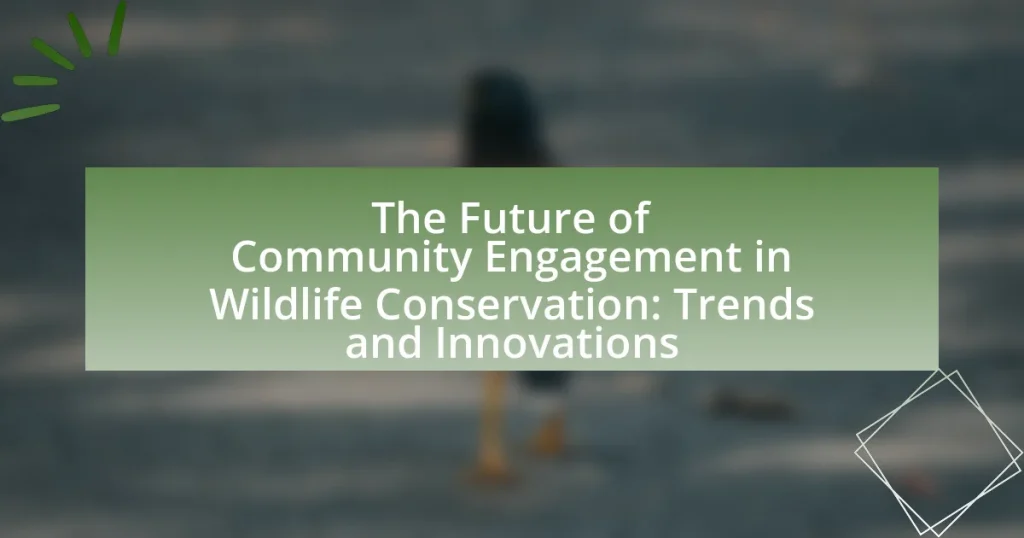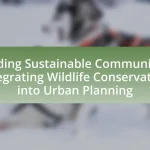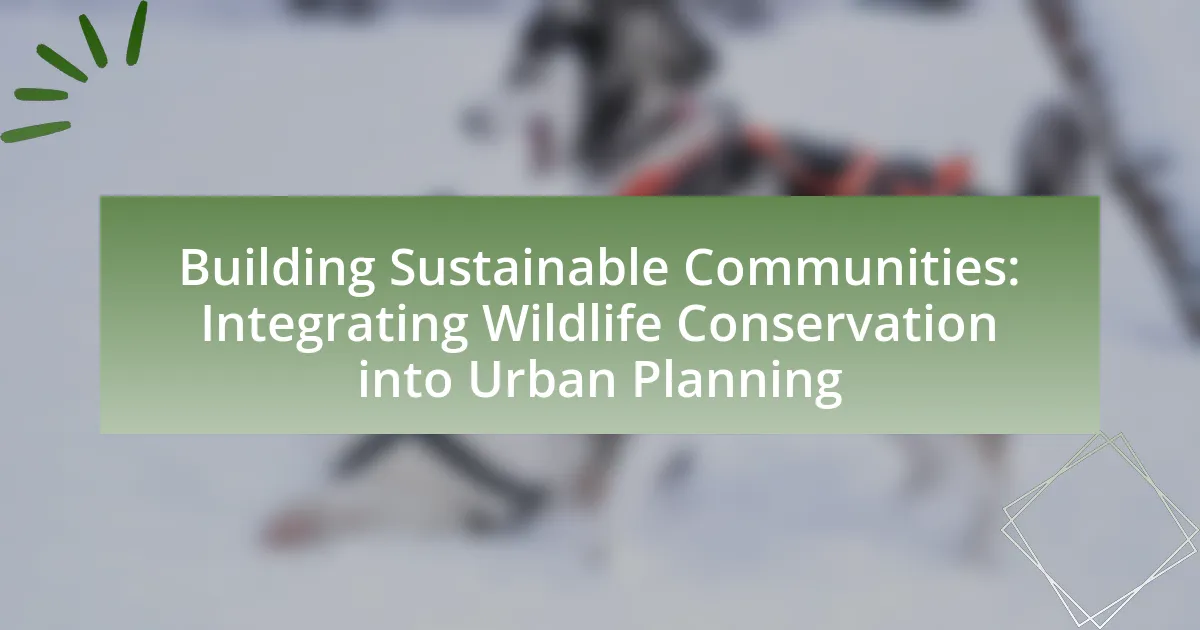The article focuses on the future of community engagement in wildlife conservation, emphasizing the increasing reliance on technology and collaborative approaches. It defines community engagement as the active participation of local communities in conservation decision-making, highlighting its importance for effective outcomes. Key elements of successful engagement include clear communication, mutual respect, and collaboration, while emerging trends such as digital tools and partnerships are transforming conservation strategies. The article also discusses the role of local knowledge, the benefits of community involvement, and the challenges faced in engaging communities, providing practical steps for enhancing participation in conservation initiatives.
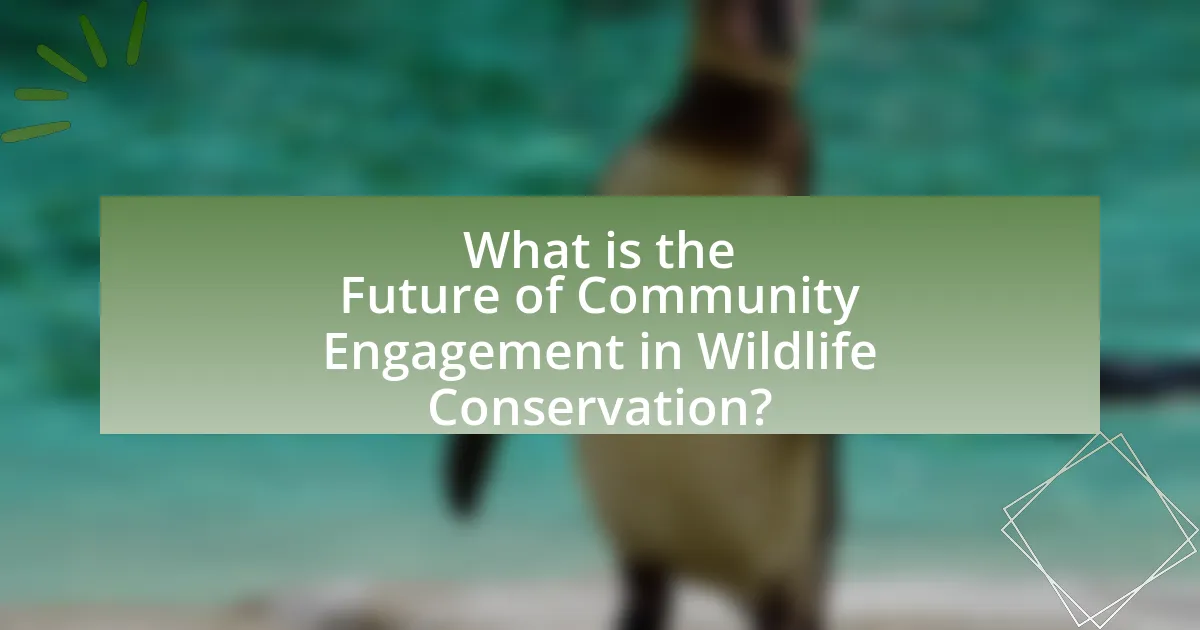
What is the Future of Community Engagement in Wildlife Conservation?
The future of community engagement in wildlife conservation will increasingly rely on technology and collaborative approaches. Innovations such as mobile apps for reporting wildlife sightings and community-driven conservation projects are becoming essential tools. For instance, the use of citizen science platforms has shown that involving local communities can lead to more effective conservation outcomes, as evidenced by projects like the Great Backyard Bird Count, which engages thousands of participants in data collection. Furthermore, partnerships between conservation organizations and local communities are expected to strengthen, as they allow for shared knowledge and resources, enhancing the overall impact of conservation efforts.
How is community engagement defined in the context of wildlife conservation?
Community engagement in the context of wildlife conservation is defined as the active participation of local communities in the decision-making processes and actions that affect their natural environment and wildlife. This engagement fosters a sense of ownership and responsibility among community members, leading to more effective conservation outcomes. Research has shown that when communities are involved, such as in the case of community-based conservation programs, there is often a significant increase in biodiversity and habitat protection, as evidenced by successful initiatives in places like Namibia and Kenya, where local involvement has led to improved wildlife management and reduced poaching rates.
What are the key elements of effective community engagement?
The key elements of effective community engagement include clear communication, active participation, mutual respect, and collaboration. Clear communication ensures that community members understand the goals and processes involved in engagement efforts, fostering transparency. Active participation encourages community members to contribute their ideas and feedback, which enhances ownership and commitment to initiatives. Mutual respect builds trust among stakeholders, recognizing the value of diverse perspectives and experiences. Collaboration involves working together with community members and organizations to achieve common goals, leveraging resources and expertise for greater impact. These elements are supported by research indicating that successful community engagement leads to more sustainable and effective conservation outcomes, as seen in various wildlife conservation projects globally.
How does community engagement differ across various conservation projects?
Community engagement varies significantly across conservation projects based on factors such as project goals, local culture, and stakeholder involvement. For instance, projects focused on habitat restoration may prioritize local community participation to ensure sustainable practices, while wildlife protection initiatives might engage communities through education and awareness campaigns. Research indicates that projects like the “Community-Based Natural Resource Management” in Namibia have successfully integrated local communities into decision-making processes, leading to improved conservation outcomes and economic benefits. This demonstrates that tailored engagement strategies, reflecting the specific context and needs of the community, are crucial for the success of conservation efforts.
Why is community engagement crucial for wildlife conservation?
Community engagement is crucial for wildlife conservation because it fosters local stewardship and enhances the effectiveness of conservation efforts. When communities are actively involved, they develop a sense of ownership and responsibility towards their local ecosystems, leading to more sustainable practices. Research indicates that conservation initiatives that incorporate community input and participation are more successful; for example, a study published in the journal “Conservation Biology” found that community-led conservation projects in Madagascar resulted in a 50% increase in forest cover over a decade. This demonstrates that engaging local populations not only improves conservation outcomes but also ensures that the needs and knowledge of those most affected by conservation policies are respected and integrated.
What role does local knowledge play in conservation efforts?
Local knowledge plays a crucial role in conservation efforts by providing insights into local ecosystems, species behavior, and sustainable practices. This knowledge, often accumulated over generations, helps conservationists understand the specific needs and challenges of the environment they aim to protect. For instance, studies have shown that indigenous communities possess detailed knowledge about biodiversity and resource management, which can enhance conservation strategies. Research published in the journal “Conservation Biology” highlights that integrating local knowledge with scientific approaches leads to more effective conservation outcomes, as it fosters community involvement and ensures that strategies are culturally relevant and ecologically sound.
How can community engagement enhance conservation outcomes?
Community engagement enhances conservation outcomes by fostering local stewardship and increasing awareness of environmental issues. When communities actively participate in conservation efforts, they are more likely to develop a sense of ownership and responsibility towards their natural resources. Research indicates that projects involving local communities often see higher success rates; for instance, a study published in the journal “Conservation Biology” found that community-led initiatives in Madagascar resulted in a 50% increase in forest cover over a decade. This demonstrates that when local populations are engaged, they can effectively contribute to sustainable practices and biodiversity preservation.
What trends are shaping the future of community engagement in wildlife conservation?
Trends shaping the future of community engagement in wildlife conservation include the rise of digital technology, increased emphasis on local knowledge, and collaborative conservation efforts. Digital platforms facilitate real-time communication and data sharing, enhancing community involvement and awareness. For instance, mobile apps and social media campaigns have proven effective in mobilizing local populations for conservation initiatives. Additionally, recognizing the value of indigenous and local knowledge fosters more inclusive conservation strategies, as seen in projects that integrate traditional ecological practices with modern conservation science. Collaborative efforts, such as partnerships between NGOs, governments, and local communities, are increasingly common, exemplified by initiatives like the Global Environment Facility’s community-based projects that empower local stakeholders in decision-making processes. These trends collectively enhance the effectiveness and sustainability of wildlife conservation efforts.
How are technological advancements influencing community participation?
Technological advancements are significantly enhancing community participation by providing accessible platforms for engagement and information sharing. Digital tools such as social media, mobile applications, and online forums facilitate real-time communication and collaboration among community members, allowing for greater involvement in wildlife conservation efforts. For instance, platforms like iNaturalist enable users to document and share wildlife observations, fostering a sense of community and collective action. Additionally, data analytics and geographic information systems (GIS) empower communities to visualize environmental changes and participate in decision-making processes, thereby increasing transparency and accountability in conservation initiatives. These advancements not only democratize access to information but also encourage active participation, leading to more effective conservation outcomes.
What are the emerging models of community engagement in conservation?
Emerging models of community engagement in conservation include participatory governance, co-management, and citizen science initiatives. Participatory governance involves local communities in decision-making processes, ensuring their voices influence conservation policies. Co-management models foster partnerships between communities and conservation organizations, sharing responsibilities and benefits, which has been shown to enhance local stewardship and biodiversity outcomes. Citizen science initiatives empower individuals to contribute to data collection and monitoring, increasing public awareness and involvement in conservation efforts. These models are supported by evidence indicating that inclusive approaches lead to more effective and sustainable conservation practices.
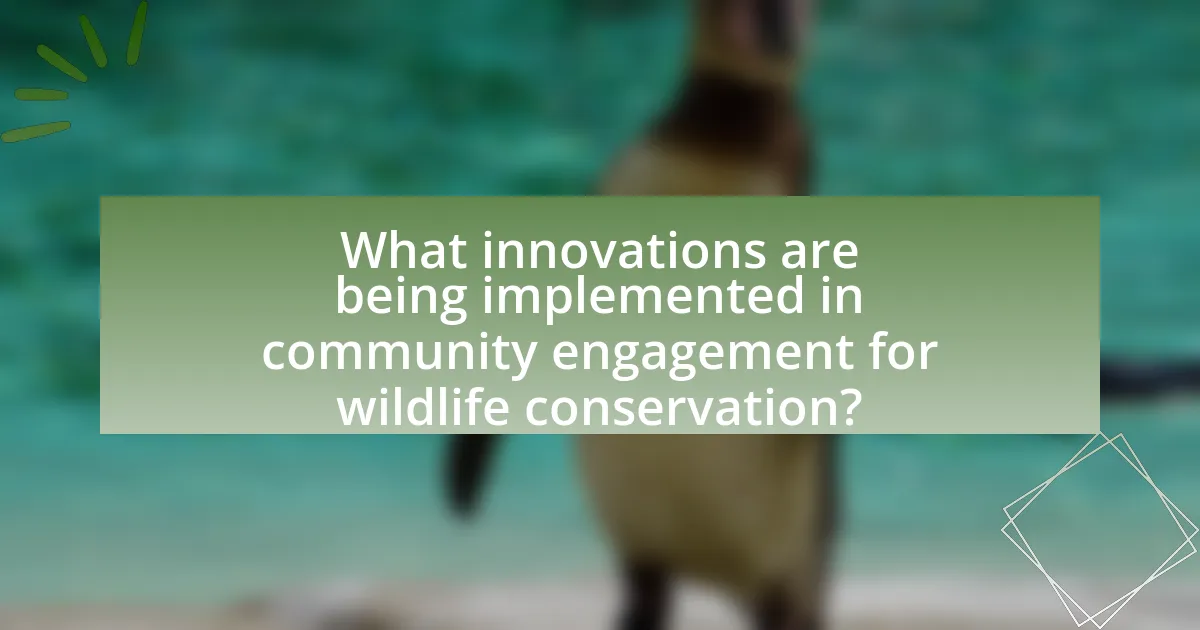
What innovations are being implemented in community engagement for wildlife conservation?
Innovations in community engagement for wildlife conservation include the use of mobile technology, social media platforms, and participatory mapping tools. Mobile technology enables real-time reporting of wildlife sightings and poaching incidents, enhancing community involvement and data collection. Social media platforms facilitate awareness campaigns and foster community discussions, allowing local voices to be heard in conservation efforts. Participatory mapping tools empower communities to visualize and manage their natural resources collaboratively, leading to more effective conservation strategies. These innovations are supported by studies showing increased community participation and improved conservation outcomes when local stakeholders are actively engaged.
How are social media and digital platforms transforming engagement strategies?
Social media and digital platforms are transforming engagement strategies by enabling real-time interaction and fostering community building among stakeholders. These platforms allow organizations to share information instantly, mobilize support for conservation efforts, and create interactive content that encourages participation. For instance, studies show that campaigns utilizing social media can increase public awareness and involvement by up to 60%, as seen in initiatives like the Ice Bucket Challenge, which raised significant funds for ALS research. This shift towards digital engagement not only broadens the reach of conservation messages but also enhances collaboration among diverse groups, making engagement more inclusive and effective.
What are the benefits of using social media for conservation messaging?
Using social media for conservation messaging enhances outreach, engagement, and awareness among diverse audiences. Social media platforms allow conservation organizations to share real-time updates, educational content, and success stories, reaching millions globally. For instance, a study by the Pew Research Center found that 69% of adults in the U.S. use social media, providing a vast audience for conservation messages. Additionally, social media facilitates community building, enabling users to connect with like-minded individuals and organizations, fostering a sense of collective action. This interconnectedness can lead to increased volunteerism and donations, as evidenced by campaigns like #GivingTuesday, which saw a 29% increase in online donations in 2020 compared to the previous year. Overall, social media serves as a powerful tool for amplifying conservation efforts and mobilizing public support.
How can digital tools facilitate community involvement in conservation projects?
Digital tools facilitate community involvement in conservation projects by enhancing communication, engagement, and data collection. These tools, such as mobile apps and social media platforms, allow communities to share information, report wildlife sightings, and participate in conservation activities in real-time. For instance, platforms like iNaturalist enable users to document biodiversity, contributing valuable data to conservation efforts while fostering a sense of community ownership. Additionally, online crowdfunding platforms have successfully funded local conservation initiatives, demonstrating that digital tools can mobilize financial support and community participation effectively.
What role do partnerships play in innovative community engagement?
Partnerships play a crucial role in innovative community engagement by facilitating collaboration between diverse stakeholders, including local communities, conservation organizations, and government entities. This collaboration enhances resource sharing, knowledge exchange, and collective problem-solving, which are essential for addressing complex wildlife conservation challenges. For instance, the partnership between the World Wildlife Fund and local communities in various regions has led to successful conservation initiatives that incorporate local knowledge and practices, resulting in improved biodiversity outcomes. Such partnerships not only empower communities but also foster a sense of ownership and responsibility towards conservation efforts, ultimately leading to more sustainable and effective engagement strategies.
How can collaborations between NGOs and local communities enhance conservation efforts?
Collaborations between NGOs and local communities enhance conservation efforts by leveraging local knowledge and fostering community ownership of conservation initiatives. Local communities possess invaluable insights into their ecosystems, which NGOs can utilize to develop effective conservation strategies. For instance, a study by the World Wildlife Fund found that community-led conservation projects in Madagascar led to a 30% increase in biodiversity in protected areas, demonstrating the effectiveness of local involvement. Additionally, when communities are engaged in conservation, they are more likely to support and sustain these efforts, as seen in the case of the Maasai Mara Wildlife Conservancies in Kenya, where local participation has resulted in improved wildlife populations and habitat preservation.
What are successful examples of partnerships in wildlife conservation?
Successful examples of partnerships in wildlife conservation include the collaboration between the World Wildlife Fund (WWF) and various local communities in the Amazon rainforest. This partnership focuses on sustainable land management practices that benefit both wildlife and local livelihoods. For instance, WWF has worked with indigenous groups to implement eco-friendly agricultural techniques, which have led to a 30% reduction in deforestation rates in certain areas. Another notable example is the partnership between the African Wildlife Foundation (AWF) and local governments in Kenya, which has resulted in the establishment of community conservancies that protect wildlife while providing economic benefits to local populations. These conservancies have increased wildlife populations by over 50% in some regions, demonstrating the effectiveness of community-based conservation strategies.

How can communities effectively engage in wildlife conservation initiatives?
Communities can effectively engage in wildlife conservation initiatives by forming partnerships with local organizations, government agencies, and conservation groups to create and implement conservation strategies. Collaborative efforts, such as community-led wildlife monitoring programs, have been shown to enhance local stewardship and increase biodiversity. For instance, the “Community-Based Conservation” model has successfully improved habitat protection in various regions, demonstrating that local involvement leads to better conservation outcomes. Engaging community members through education and awareness campaigns also fosters a sense of ownership and responsibility towards local wildlife, further solidifying their commitment to conservation efforts.
What best practices should communities adopt for successful engagement?
Communities should adopt inclusive communication, active participation, and collaborative decision-making as best practices for successful engagement. Inclusive communication ensures that all voices are heard, fostering a sense of belonging and trust among community members. Active participation encourages individuals to contribute their ideas and feedback, which enhances the quality of engagement and leads to more effective conservation strategies. Collaborative decision-making involves stakeholders in the planning and implementation processes, which has been shown to increase commitment and ownership of conservation initiatives, as evidenced by the success of community-led projects in various regions.
How can communities leverage local resources for conservation efforts?
Communities can leverage local resources for conservation efforts by utilizing native species, local knowledge, and community engagement to enhance biodiversity and sustainability. For instance, local flora and fauna can be integrated into conservation projects, promoting ecological balance while reducing costs associated with importing non-native species. Additionally, community members often possess valuable traditional ecological knowledge that can inform conservation strategies, as evidenced by studies showing that indigenous practices can lead to more effective resource management. Engaging local stakeholders fosters a sense of ownership and responsibility, which has been linked to increased participation in conservation activities, as demonstrated by successful community-led initiatives in various regions.
What strategies can be employed to sustain community interest in conservation?
To sustain community interest in conservation, strategies such as education, participatory initiatives, and local partnerships can be employed. Education programs that inform community members about local ecosystems and the importance of biodiversity foster a sense of responsibility and connection to the environment. Participatory initiatives, such as community-led conservation projects, engage residents directly in conservation efforts, enhancing ownership and commitment. Local partnerships with schools, businesses, and non-profits can amplify resources and outreach, creating a collaborative approach that strengthens community ties to conservation efforts. Research indicates that communities involved in conservation activities are more likely to support and sustain these initiatives over time, as seen in successful programs like the Community-Based Natural Resource Management in Namibia, which has led to increased wildlife populations and community benefits.
What challenges do communities face in engaging with wildlife conservation?
Communities face several challenges in engaging with wildlife conservation, primarily including lack of funding, insufficient education, and conflicting interests. Limited financial resources hinder the ability to implement conservation projects effectively, as many initiatives require substantial investment for sustainability. Additionally, inadequate education and awareness about the importance of wildlife conservation can lead to apathy or resistance among community members, reducing participation. Conflicting interests, such as economic development versus conservation efforts, often create tension, making it difficult for communities to prioritize wildlife protection. These challenges are supported by studies indicating that financial constraints and lack of awareness are significant barriers to effective community engagement in conservation efforts.
How can communities overcome barriers to participation?
Communities can overcome barriers to participation by implementing inclusive outreach strategies that engage diverse populations. For instance, utilizing local leaders and organizations to disseminate information can enhance trust and accessibility, as evidenced by the success of community-led initiatives in various conservation projects. Research shows that when communities actively involve marginalized groups, participation rates increase significantly, leading to more effective conservation outcomes. This approach not only addresses logistical barriers but also fosters a sense of ownership and responsibility among community members, ultimately enhancing their engagement in wildlife conservation efforts.
What support systems are necessary for effective community engagement?
Effective community engagement requires support systems such as communication platforms, training programs, and collaborative networks. Communication platforms facilitate information sharing and feedback between stakeholders, ensuring transparency and inclusivity. Training programs equip community members with the necessary skills and knowledge to participate actively in conservation efforts. Collaborative networks foster partnerships among local organizations, government agencies, and conservation groups, enhancing resource sharing and collective action. Research indicates that communities engaged through these support systems are more likely to contribute to successful wildlife conservation outcomes, as evidenced by case studies in various regions where structured engagement led to increased local participation and improved conservation results.
What practical steps can communities take to enhance their engagement in wildlife conservation?
Communities can enhance their engagement in wildlife conservation by implementing educational programs that raise awareness about local wildlife and ecosystems. These programs can include workshops, school curricula, and community events that inform residents about the importance of biodiversity and conservation efforts. Research shows that communities with active educational initiatives see increased participation in conservation activities, as individuals become more knowledgeable and invested in protecting their local environment. For instance, a study published in the Journal of Environmental Management found that community-based education significantly improved local conservation outcomes by fostering a sense of stewardship among residents.
